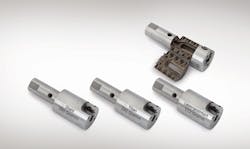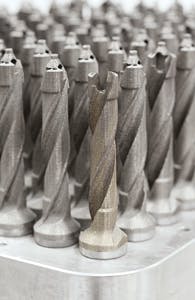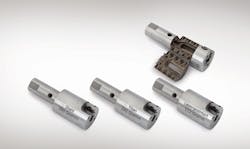Mapal relies on additive manufacturing to produce insert drills
Lichtenfels, Germany - Precision tool specialist Mapal is using additive manufacturing to produce drills, with amazing results. The company now relies on additive tool solutions with LaserCUSING systems by Concept Laser.
High performance, long service lives, and rapid tool changes are the central requirements for modern tool concepts. Mapal's QTD insert drill (FIGURE 1) excels with good chip deformation and reliable chip removal. Thanks to its geometry, precision features make high cutting specifications and drill quality possible. They now offer four types of the inserts for steel, stainless steel, cast iron, and aluminum.
Additive manufacturing from metal powder using laser melting systems by Concept Laser makes entirely new design approaches possible. The QTD insert drill was previously available in diameters of 13mm and greater, limited by the coolant supply in the tool body. The smaller the tool body, the greater the adverse effect the standard central coolant supply on the tool's performance. Central coolant supply weakens the core of the drill and makes it unstable. In addition to this, the cooling channels must be ever smaller, reducing the flow of coolant to the insert. The new steel tool body design with spiral cooling channels is not usually used for small diameters. A new spiral cooling concept allows even solid drills to be produced in the 8–12mm diameter range.
The new QTD insert drills are manufactured using additive laser melting. These are hybrid-manufactured parts: The tool shank is machined conventionally and the drill is laser melted with additive methods. This approach makes the manufacturing process significantly more economical. Unmanned manufacturing and a reduction of tooling-up times and reworking in the digital laser melting approach are other aspects that improve the economy. However, the greatest advantage of transitioning from a conventional manufacturing strategy to additive manufacturing was that it facilitated an entirely new geometry, increasing the performance of the tools.
The additive-manufactured insert drill has a cooling concept with spiral ducts, which improves the cooling performance. Compared with the previous central coolant supply, a spiral coolant routing increases the coolant flow by 100%. It also increases the core stability with coolant ducts which run parallel to the flute. The cooling is also improved by the new coolant duct profiles, which deviate from the usual circular form with a slightly triangular shape that optimizes the geometrical moment of inertia and the flow rate. Tests found that choosing a cross-section of this type increases the flow quantity by 30%.
The new cooling concept means that better cooled drills are available for longer drilling tasks and also allows expanding the range with smaller stainless steel drill diameters. Tension must be removed from conventionally manufactured parts after machining because of the immense forces to which they are subjected. That is not the case for LaserCUSING—constantly changing exposure locations in the geometry mean that the tension is removed from the part internally during the build process.
Two Concept Laser M1 cusing systems with a central material supply container are used. The systems have a build envelope of 250 × 250 × 250mm. The QTD insert drills are created as 10 × 10 or 11 × 11 unit solution in this build envelope. One hundred to 121 drills are produced in one setup. The build rates of the 400W lasers are between 6 and 18cm3/h. To avoid contamination, M1 cusing operates under a nitrogen protection gas atmosphere. During processing, the laser heats the powder material to 60–70°C for fusing. The thermal expansion in the build process has to be taken into consideration in the design. After initial successes with series products, the demand for internal capacities is also growing, so production availability is 24 hours each day of the week with unmanned production.
Mapal chose Concept Laser for its strengths in equipment handling, accessibility, user-friendliness, and open variation of parameters for process design. Variable parameters are particularly interesting for tests and new products to define an optional process. For topology options, Concept Laser systems stand out because of their stochastic control of the slice segments (also referred to as "islands"), which are processed successively. This exposure strategy induces the lowest tension in the component.
The changes in the design are also apparent in other areas at Mapal. The company's weight-optimized, laser-melted external reamers are new (FIGURE 2). The lighter the external reamers are, the better they work, which is particularly true for machining small-diameter shafts. Conventionally manufactured 8.5mm steel external reamers already weigh 400g. This weight and the resulting mass inertia severely restrict the maximum step speeds. Additive manufacturing allows lightweight external reamers to be built with integrated balancing potential. A rib structure, specially designed for the application, which has been registered for a patent, reduces the "new" 8.5mm external reamer's weight to 172g. That is a weight saving of 57%, which results in a better performance for this rotating component-machining is faster and precision is greater.
Additive manufacturing strategies have been shown to boost competitiveness, economy, and value-add. Dr. Dirk Sellmer, head of testing and development at Mapal, says, "Parts of the future are more intelligent or complex, and also offer better performance. They also give us new design options. And that will result in new geometries with new performance features." In general, additive manufacturing facilitates new product solutions, which would be inconceivable with conventional methods. Every project implemented is a learning experience. This knowledge is then used in new, future projects.
Besides optimizing the quality, Mapal prioritizes process management for additive manufacturing with better surfaces closer to the precision component. Both cryogenic chip removal and the requests for closed cooling circuits and chambers make new requirements of the technology.


